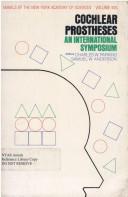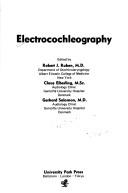| Listing 1 - 8 of 8 |
Sort by
|

ISBN: 0897662032 9780897662031 Year: 1983 Publisher: New York (N.Y.): New York Academy of Sciences,
Abstract | Keywords | Export | Availability | Bookmark
 Loading...
Loading...Choose an application
- Reference Manager
- EndNote
- RefWorks (Direct export to RefWorks)
Book
Year: 1982 Publisher: Halle (Saale) : Abt. Wissenschaftspublizistik der Martin-Luther-Universität Halle-Wittenberg,
Abstract | Keywords | Export | Availability | Bookmark
 Loading...
Loading...Choose an application
- Reference Manager
- EndNote
- RefWorks (Direct export to RefWorks)
Cochlea --- Cochlea --- Audiometry, Evoked response --- Electrocochleography --- Diseases

ISBN: 083910846X Year: 1976 Publisher: Baltimore University Park press
Abstract | Keywords | Export | Availability | Bookmark
 Loading...
Loading...Choose an application
- Reference Manager
- EndNote
- RefWorks (Direct export to RefWorks)
Electrocochleography --- Cochlea --- Electrodiagnosis --- Electrophysiology --- Hearing Disorders --- Congresses --- physiology --- diagnosis
Book
Year: 1976 Publisher: Halle (Saale) : Martin-Luther-Universität Halle-Wittenberg,
Abstract | Keywords | Export | Availability | Bookmark
 Loading...
Loading...Choose an application
- Reference Manager
- EndNote
- RefWorks (Direct export to RefWorks)
Acoustic trauma --- Audiometry, Evoked response --- Cochlea --- Cochlea --- Electrocochleography --- Ototoxic agents --- Congresses. --- Congresses. --- Diseases --- Congresses. --- Congresses. --- Congresses.
Book
Year: 2018 Publisher: Frontiers Media SA
Abstract | Keywords | Export | Availability | Bookmark
 Loading...
Loading...Choose an application
- Reference Manager
- EndNote
- RefWorks (Direct export to RefWorks)
Electrocochleography (ECochG) is an approach for objective measurements of physiologic responses from the inner ear. Measurements have classically been made from electrodes placed in the outer ear canal, on the tympanic membrane, the round window niche, or inside the cochlea. Recent innovations have led to ECochG being used for exciting new purposes that drive clinical practice and contribute to the basic understanding of inner ear physiology. Cochlear implant recording electrodes can monitor the preservation of residual, low-frequency acoustic hearing, both in the operating room and post-operatively. ECochG measurements can quantify differential effects of inner ear surgery or other manipulations on vestibular and auditory physiology simultaneously. Various attributes of cognitive neuroscience can be addressed with ECochG measurements from the auditory periphery. These advances in ECochG provide a way to understand a variety of inner ear diseases and are likely to be of value to many groups in their own clinical and basic research.
cochlear microphonic --- cochlear action potential --- sensorineural hearing loss --- compound action potential --- auditory nerve --- medial olivocochlear efferent reflex --- electrocochleography --- summating potential --- cochlear microphonic --- cochlear action potential --- sensorineural hearing loss --- compound action potential --- auditory nerve --- medial olivocochlear efferent reflex --- electrocochleography --- summating potential
Book
Year: 2018 Publisher: Frontiers Media SA
Abstract | Keywords | Export | Availability | Bookmark
 Loading...
Loading...Choose an application
- Reference Manager
- EndNote
- RefWorks (Direct export to RefWorks)
Electrocochleography (ECochG) is an approach for objective measurements of physiologic responses from the inner ear. Measurements have classically been made from electrodes placed in the outer ear canal, on the tympanic membrane, the round window niche, or inside the cochlea. Recent innovations have led to ECochG being used for exciting new purposes that drive clinical practice and contribute to the basic understanding of inner ear physiology. Cochlear implant recording electrodes can monitor the preservation of residual, low-frequency acoustic hearing, both in the operating room and post-operatively. ECochG measurements can quantify differential effects of inner ear surgery or other manipulations on vestibular and auditory physiology simultaneously. Various attributes of cognitive neuroscience can be addressed with ECochG measurements from the auditory periphery. These advances in ECochG provide a way to understand a variety of inner ear diseases and are likely to be of value to many groups in their own clinical and basic research.
Book
Year: 2018 Publisher: Frontiers Media SA
Abstract | Keywords | Export | Availability | Bookmark
 Loading...
Loading...Choose an application
- Reference Manager
- EndNote
- RefWorks (Direct export to RefWorks)
Electrocochleography (ECochG) is an approach for objective measurements of physiologic responses from the inner ear. Measurements have classically been made from electrodes placed in the outer ear canal, on the tympanic membrane, the round window niche, or inside the cochlea. Recent innovations have led to ECochG being used for exciting new purposes that drive clinical practice and contribute to the basic understanding of inner ear physiology. Cochlear implant recording electrodes can monitor the preservation of residual, low-frequency acoustic hearing, both in the operating room and post-operatively. ECochG measurements can quantify differential effects of inner ear surgery or other manipulations on vestibular and auditory physiology simultaneously. Various attributes of cognitive neuroscience can be addressed with ECochG measurements from the auditory periphery. These advances in ECochG provide a way to understand a variety of inner ear diseases and are likely to be of value to many groups in their own clinical and basic research.
Book
ISBN: 9811002479 9811002487 Year: 2016 Publisher: Singapore : Springer Singapore : Imprint: Springer,
Abstract | Keywords | Export | Availability | Bookmark
 Loading...
Loading...Choose an application
- Reference Manager
- EndNote
- RefWorks (Direct export to RefWorks)
This book presents a new approach to examining perceived quality of audiovisual sequences. It uses electroencephalography to understand how exactly user quality judgments are formed within a test participant, and what might be the physiologically-based implications when being exposed to lower quality media. The book redefines experimental paradigms of using EEG in the area of quality assessment so that they better suit the requirements of standard subjective quality testings. Therefore, experimental protocols and stimuli are adjusted accordingly. .
Electrical Engineering --- Electrical & Computer Engineering --- Engineering & Applied Sciences --- Auditory perception. --- Visual perception. --- Electrocochleography. --- Cochlear audiometry --- Optics, Psychological --- Vision --- Sound perception --- Psychological aspects --- Audiometry --- Electrodiagnosis --- Electrophysiology --- Hearing disorders --- Perception --- Visual discrimination --- Hearing --- Word deafness --- Diagnosis --- Telecommunication. --- Computer science. --- Psychology, clinical. --- Communications Engineering, Networks. --- User Interfaces and Human Computer Interaction. --- Neuropsychology. --- Informatics --- Science --- Electric communication --- Mass communication --- Telecom --- Telecommunication industry --- Telecommunications --- Communication --- Information theory --- Telecommuting --- Electrical engineering. --- User interfaces (Computer systems). --- Neurophysiology --- Psychophysiology --- Interfaces, User (Computer systems) --- Human-machine systems --- Human-computer interaction --- Electric engineering --- Engineering
| Listing 1 - 8 of 8 |
Sort by
|

 Search
Search Feedback
Feedback About UniCat
About UniCat  Help
Help News
News